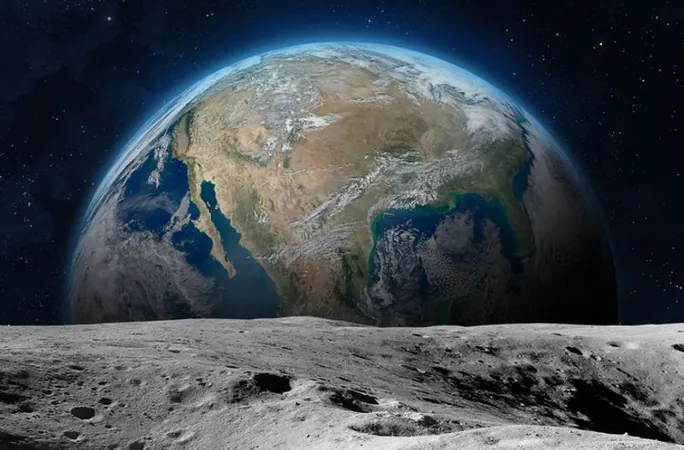
The Moon: The New Frontier of Silicon Valley Powered by AI
2025-06-06
Author: Ming
Imagine a Future on the Moon
Picture this: It’s 2035, and a robotic engineer on the moon is mining rare fuel capable of powering Earth. Nearby, advanced machines utilize moon dust to 3D print entire structures. Above, satellites are transmitting secure data seamlessly. What's astonishing? This lunar evolution is entirely managed by Artificial Intelligence.
What once seemed like a distant dream is now becoming a reality. The moon has transformed from a mere celestial body into a bustling hub of innovation, equipped to host labs, factories, and potentially even tourism—all orchestrated by the brilliance of AI.
The Lunar Race Begins
Historically, space exploration was fueled by national pride—voyages to plant flags or send astronauts into orbit. However, the moon is reshaping this narrative into a technological epicenter. With its low gravity and extreme environment, it serves as the perfect testbed for groundbreaking developments in quantum physics, AI robotics, and resource mining, heralding the dawn of a new technological revolution comparable to the rise of Silicon Valley.
AI: The Powerhouse Behind Moon Missions
On our home planet, AI is already transforming daily life—booking tickets, assisting with virtual tasks, and aiding in medical diagnoses. But the role of AI on the moon is far more critical. Here, it’s not merely a tool; it’s the brain behind the mission.
The moon’s inhospitable environment lacks air, fresh water, and immediate human assistance. With radio signals from Earth taking over a second to arrive, real-time communication is impossible. Consequently, AI must step up to think and react autonomously.
Innovations Transforming Lunar Exploration
Here's how AI is revolutionizing moon exploration:
1. **Autonomous Landing and Navigation**: Landing isn’t as simple as hitting a parking spot; it requires precision. AI systems are currently being trained to navigate and land safely despite a lack of maps or GPS.
2. **Smart Rovers and Explorers**: Traditional rovers that relied on Earth-based commands are evolving into self-operating AI robots that identify key samples and adapt their paths independently—akin to self-driving vehicles, but on the moon.
3. **3D Printing and Construction**: Instead of sending construction materials from Earth, AI will command 3D printers utilizing moon dust to create structures and tools, with real-time monitoring of conditions, a concept already being explored by the European Space Agency.
4. **Astronaut Health and Safety**: On extended missions, keeping astronauts healthy is crucial. AI will supervise their well-being, monitoring for stress or illness and providing essential support.
5. **Instant Decision-Making**: Most importantly, AI excels at making rapid decisions that are vital in emergencies, such as rerouting power or alerting astronauts to seek shelter from solar storms. In this arena, swift action can mean the difference between catastrophe and success.
The Moon as a Quantum Tech Hub
Additionally, the moon presents a golden opportunity for advancing quantum technology—where quantum computers and communication systems could create a more secure and faster internet. Earth’s noisy backdrop is no match for the moon's tranquility, making it ideal for testing these networks under AI coordination.
Who's Leading the Charge?
Currently, the lunar race is driven mainly by the United States and China, with NASA's Artemis mission aimed at establishing a permanent lunar base. Meanwhile, China collaborates with Russia to build its own lunar research station. Various private enterprises are getting involved, crafting rockets and habitats, competing for a stake in lunar technology and the next wave of innovation.
A Call to Action for Global Participation
While India celebrated its Chandrayaan-3 mission, it’s essential to adopt a broader perspective—developing AI systems, investing in quantum communications, and robotic engineering to harness this lunar tech boom. Countries of the Global South must act now, or face the prospect of becoming mere consumers of foreign innovations.
As a child in India, I gazed up at the moon, enchanted by its lore. Today, I still look up in wonder, pondering whether we will forge this future or be mere spectators. The moon has shifted from a mere symbol of dreams into a tangible laboratory for innovation—guided by AI, science, and visionary thinkers. The time to participate is now, before the door closes.





 Brasil (PT)
Brasil (PT)
 Canada (EN)
Canada (EN)
 Chile (ES)
Chile (ES)
 Česko (CS)
Česko (CS)
 대한민국 (KO)
대한민국 (KO)
 España (ES)
España (ES)
 France (FR)
France (FR)
 Hong Kong (EN)
Hong Kong (EN)
 Italia (IT)
Italia (IT)
 日本 (JA)
日本 (JA)
 Magyarország (HU)
Magyarország (HU)
 Norge (NO)
Norge (NO)
 Polska (PL)
Polska (PL)
 Schweiz (DE)
Schweiz (DE)
 Singapore (EN)
Singapore (EN)
 Sverige (SV)
Sverige (SV)
 Suomi (FI)
Suomi (FI)
 Türkiye (TR)
Türkiye (TR)
 الإمارات العربية المتحدة (AR)
الإمارات العربية المتحدة (AR)